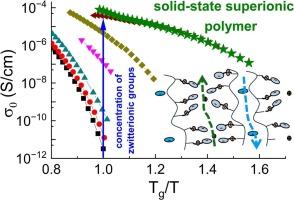Unraveling the pathway towards superionic transport in polymer electrolytes
IF 22
1区 材料科学
Q1 MATERIALS SCIENCE, MULTIDISCIPLINARY
引用次数: 0
Abstract
Ionic transport in polymers is critical for Li-ion batteries, fuel cells, flow batteries and many other energy storage and conversion technologies. A significant enhancement of ion conductivity in polymers may be achieved through an increase in the polarity of side chains and their self-organization into specific morphologies, which can potentially act as percolated ionic structures. However, higher polarity increases attractive interactions within a polymer matrix and slows down its segmental dynamics, which conversely hinders ionic transport. To overcome this tradeoff, we designed the functionalization of a Li salt-doped polymer matrix by tailored amounts of zwitterionic (ZI) groups. Our results suggest the emergence of a self-assembled percolation conductivity regime above a specific ZI concentration, in which ion hopping decouples from segmental dynamics by up to ten orders of magnitude. Consequently, in the highly concentrated ZI regime, our polymeric materials exhibit in their glassy state energy barriers for ion hopping similar to, or even smaller than, those reported for superionic ceramics. Our study also reveals that ion dynamics in the poly(zwitterion) with all monomers carrying ZI groups is significantly faster than that of a monomeric ZI compound, although the latter has much faster structural relaxation. This result highlights the crucial role played by the local morphology on the ion transport of polymer electrolytes and opens a new pathway for the design of superionic polymers, significantly expanding the current limited portfolio of solid-state electrolytes for energy applications.

揭示聚合物电解质中超离子传输的途径
聚合物中的离子传输对于锂离子电池、燃料电池、液流电池和许多其他能量存储和转换技术至关重要。聚合物中离子电导率的显著增强可以通过增加侧链的极性和它们的自组织成特定的形态来实现,这可以潜在地作为渗透离子结构。然而,更高的极性增加了聚合物基体内的吸引相互作用,减缓了其片段动力学,反过来阻碍了离子传输。为了克服这种权衡,我们通过定制数量的两性离子(ZI)基团设计了Li盐掺杂聚合物基体的功能化。我们的研究结果表明,在特定的ZI浓度以上,出现了一种自组装的渗透电导率制度,其中离子跳变与节段动力学解耦高达十个数量级。因此,在高度集中的ZI状态下,我们的聚合物材料表现出与超离子陶瓷相似甚至更小的玻璃态离子跃迁能垒。我们的研究还表明,所有携带ZI基团的单体的聚(两性离子)中的离子动力学明显快于单体ZI化合物,尽管后者具有更快的结构弛豫。这一结果突出了局部形态对聚合物电解质离子传输的关键作用,为超离子聚合物的设计开辟了新的途径,极大地扩展了目前有限的能源应用固态电解质组合。
本文章由计算机程序翻译,如有差异,请以英文原文为准。
求助全文
约1分钟内获得全文
求助全文
来源期刊

Materials Today
工程技术-材料科学:综合
CiteScore
36.30
自引率
1.20%
发文量
237
审稿时长
23 days
期刊介绍:
Materials Today is the leading journal in the Materials Today family, focusing on the latest and most impactful work in the materials science community. With a reputation for excellence in news and reviews, the journal has now expanded its coverage to include original research and aims to be at the forefront of the field.
We welcome comprehensive articles, short communications, and review articles from established leaders in the rapidly evolving fields of materials science and related disciplines. We strive to provide authors with rigorous peer review, fast publication, and maximum exposure for their work. While we only accept the most significant manuscripts, our speedy evaluation process ensures that there are no unnecessary publication delays.
 求助内容:
求助内容: 应助结果提醒方式:
应助结果提醒方式:


